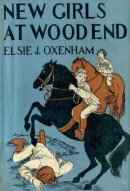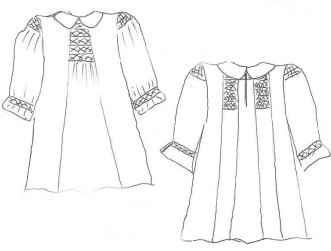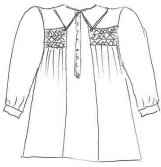| bc |
ROUND FROCKS OR SMOCKS
by Pat Mitchell
Updated 11th January, 2015.
This
page is part of
COLLECTING
BOOKS and MAGAZINES,
Blue Mountains, Australia
SERVING COLLECTORS SINCE JULY, 1997
The word ‘smock’ is an old English word for a shift or chemise, hence the
word ‘smocking’ came to be applied to the ornamental gathering of the necks of
these garments.
The earliest smocks were simple shirt-like garments and came into being in Anglo-Saxon
times. Many European countries also used smocking on their garments. They gradually
developed into a fuller garment with much more room to move while working. The fullness
was gathered in tubes or reeds at both back and front. These garments, known as
‘smock frocks’, were worn in England by the shepherds, carters and wagoners in
the 1700s. Not much is recorded of the wearing apparel of the working class up to this
period but occasionally in paintings of rural life one can see them.
Most smocks were made from a rough homespun and home woven linen or wool. They were quite
heavy and provided extra warmth for the wearers while protecting their everyday clothes.
The cut of these garments was simple and the basic sections were squares or rectangles.
There were three styles - the Round Smock (Frock), the Shirt Smock and the Coat Smock.
THE ROUND SMOCK as worn by the girls
of Woodend School is considered to be the most traditional. It usually has a peter-pan
collar and a generous neck opening either front or back. This made it very easy to slip
on. There was smocking at the centre back, front, upper sleeves and wrist. The round
frocks were reversible and were not washed until both sides were dirty. They were mostly
knee length or shorter.
In Chapter 1 of ‘Rosamund’s tuckshop’ we meet Rhoda Kane and Sonia Raymond
at lunch when they are discussing the uniform they are to wear at Woodend school, which
was just opening as an annex to the Cliffend School at Brighton. "We’re to wear
uniform ... Khaki breeches like those the land girls had during the war, and smocks." |

|
 |
Elsie gives a good description of them in Chapter 5 of
‘Rosamund’s Tuckshop’ ... "the new gardening mistress, coming from a
survey of the grounds, was dressed in the same uniform that Daffodil had been wearing;
khaki breeches, smocked yellow tunic to match, long boots, and soft khaki hat, with a
glimpse of red hair beneath."
In Chapter 2 of ‘Rosamund’s Castle’ we meet Benedicta when she finally gets
to school after her accident. She has just arrived and has arrayed herself in her new
outfit for the first time. "She wore yellow breeches and long brown boots, a yellow
smock hanging almost to her knees, and a soft slouch hat to match ... She stood gazing
dreamily down at the beautiful lawn, where girls in yellow smocks where working in groups
under the trees." |
Later in ‘New girls at Woodend’ Chapter 5 we meet Jean-Ann when she arrives
at school wearing her working outfit. " .. The stranger wore the khaki breeches and
lose smock, the soft hat and the long boots, which were the gardening outfit of
Woodend."
In Chapter 8 Miss Rainey tells the new juniors "They are Sussex round-frocks, made on
the pattern of the working clothes of old Sussex shepherds, up on the hills. Smocked
across the chest and fastening at the back, they are exactly like the shepherds’
smocks ... You should feel it is an honour to wear traditional garments."
| SHIRT SMOCKS are thus
named because they are similar to a nobleman’s shirt and have a short opening at the
front. They are usually shorter than round frocks |

|
COAT SMOCKS were worn mainly by the
Welsh shepherds. They were buttoned at the front and had a large cape-like collar to
protect the wearer from the wet and misty conditions in Wales. They were knee length or
longer and usually made of wool.
The gathering on the smocks began to be embroidered. It is not known why but perhaps the
fullness of the coarse material blousing out from the neckline was uncomfortable. Smocking
or embroidery held the gathers close to the chest. By the end of the 1700s the gathers
were embroidered by a strong linen thread the colour of the smock, and the embroidery
varied from area to area. Mostly natural colours from cream to dark brown, the type of
embroidery indicated the wearer’s occupation. Leaves and trees for a woodsman, crooks
and sheep for a shepherd, crosses for a gravedigger. Feather stitch was the most common.
| The tradition of wearing a smock declined by the 1800s and it was rare to
see them being worn after this time. It was about them that smocking became a fashion
statement on tea gowns, children’s wear and nightdresses. When lawn tennis became
popular in the 1800s, bodices were smocked with silk and caught at the waist by a sash.
Today once more mocking is very popular on babies’ and children’s wear. |

|
(This article first appeared in The Abbey Guardian for April, 1998.)
Back to main
Abbey page and index of EJO items.
Back
to Collecting Books & Magazines.
|
bc |



